You are what you eat. - Nutrition planning for calves
16. Januar 2023 — General Information, Calf Feeding, Calf management, Calf feeders — #weaning #Ad libitum #CalfExpert #CMR concentration #Milk replacer #MilkTaxi #Calf feeder #Feeding programs #Whole milkYou should therefore first answer the following questions before slavishly following the recommendations on the milk powder bag:
- What are the growth targets I want to achieve with my breed?
- Do I only intend to raise the calves until a certain date of sale or will they remain on my farm as breeding offspring?
- Which type of feed (whole milk, milk replacer (skimmed milk or whey)) do I wish to use?
- Which feeding method will I use (fully automated feeder, MilkTaxi or manual preparation using a bucket/feeding bottle)?
Once you have answered these questions, you can use the following information to create the right feeding curve for your farm and apply it perfectly in practice.
This article is about
1. Start of milk feeding: colostrum
Calf feeding starts in the very first hour of its life. In addition to immunoglobulins, high-quality colostrum also provides your calf with sufficient energy, protein and minerals.
Since a calf is born with very little energy reserves, the rule for the quantity is: as much as possible! This may well be 10 % of the calf's body weight in its first meal, i.e. 3-4 litres. This is of vital importance to immunise the calf, but also for its nutrition.
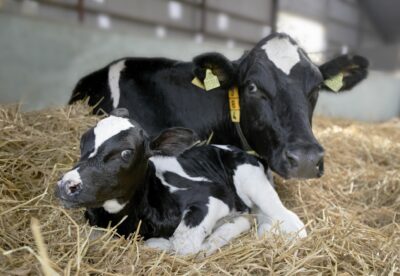
The second meal with colostrum, also defined as transition or transit milk, is not so much to immunise the calf as to provide it with sufficient nutrients. Although the immunoglobulins no longer penetrate the intestinal wall during subsequent feeds, the antibodies they contain continue to bind and fight harmful pathogens in the digestive tract. For this reason, transit milk should be fed for as long as it is available.
2. Whole milk or milk replacer
And that brings us to the most important question: what should I feed? Whole milk or milk replacer (CMR)? Both types of feed have advantages and disadvantages, which will not go into here. But one thing is certain: if feeding programmes with high amounts of milk (i.e. > 10 l milk per day up to ad libitum) are planned, a very highly digestible milk must be used. This is usually whole milk or high-quality CMR (at least 40 % skimmed milk). This is especially the case for young calves.
It is advisable to continue feeding whole milk for at least the first 2-3 weeks, since colostrum or transit milk was given in the first few days.
We have already described the requirements for successful whole milk feeding in detail in our blog "The H&L Whole Milk Story".
3. Milk replacer concentration
Please remember a few important basic points when feeding CMR:
- Avoid concentrations of milk replacer that are too low or too high.
If you feed less than 120 g CMR/l, there is a risk of digestive problems because the protein does not coagulate well in the abomasum. At concentrations above 160 g/l, some milk replacers may not dissolve well and/or excessive osmolarity in the mixed milk may cause inflammation in the gastrointestinal mucosa. Optimum concentrations of feed are between 130 g/l and 150 g/l.
- Observe the mixing recommendation of the CMR manufacturers
There is much debate about whether the CMR concentrations in grams refer to a litre of prepared feed or a litre of water. There's a huge difference of up to 15% energy density. However, conventional mixing recommendations are unfortunately still thought of from the application perspective: i.e. the recommendation "grams per litre of water" only indicates how the milk is to be mixed and not how it is to be fed to a calf.
It is therefore better to use the term % dry matter (% DM). This clearly defines the nutrient density in the prepared milk. In this blog article, we use grams per litre of prepared feed to refer to the concentration.
Important: please note that the CMR concentration you set on the CalfExpert refers to the final mixed milk: a setting of 150 g CMR concentration means 15 % DM in the milk mixture.
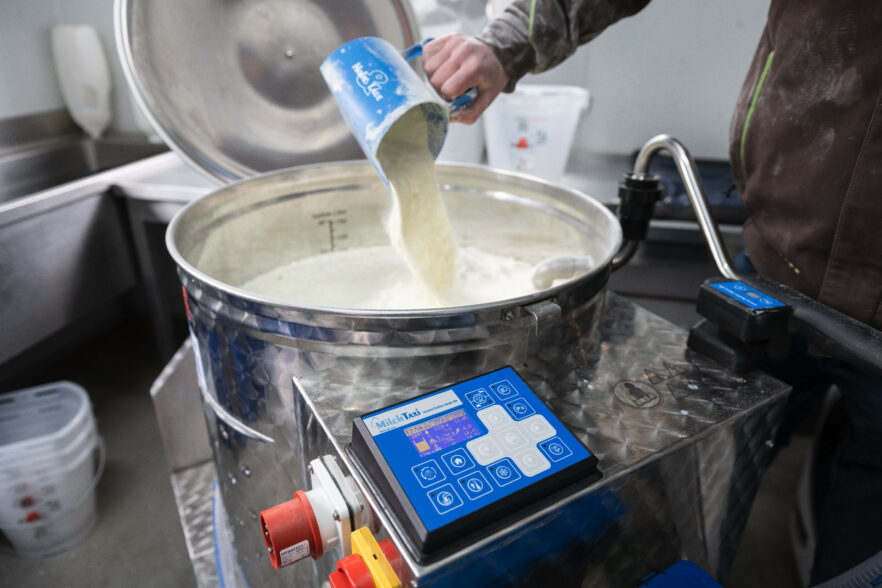
- The total energy is what matters
Care must be taken to ensure that calves receive sufficient energy to achieve the desired gains by adjusting the concentration of CMR in relation to the amount of feed. Therefore, be sure to work out the daily amount of CMR the calf receives based on the daily amount and the set concentration in order to assess what the calves actually receive.
- Avoid major changes to the feeding program.
Calves are creatures of habit. Changes to he amount and composition of their feed should always be made slowly. This is especially important when calves are switched from whole milk to milk replacer, for example. The changeover from one feed to the other should take about a week, preferably 10 days, so that the calves' digestive system can adjust to the new ingredients.
This poses problems for many farms that keep calves individually and feed them in buckets. These transitions can only be achieved using additionally mixed milk. It is important to consciously find compromises in such cases.
4. Preparing the feeding curve
In many cases, calves are still restrictively fed milk. This leaves the dairy cattle sector alone on a broad track in the agricultural world. The feed intake of offspring is not restricted in any other type of livestock. The belief that a limited supply of milk encourages calves to eat roughage at an early age, which still prevails in some cases, has been refuted by science and in practice many times over.
We now also know that metabolic programming can be expected to improve the lifetime performance of well-fed animals and hence achieve better long-term commercial results. It would therefore be wrong to save money in this area.
Which is why we say:
Always feed sufficient milk.
You should assume 12-15 % of body weight as the minimum quantity required. This means that a calf with a body weight of 50 kg should not be fed less than 6 l of milk per day. Satisfactory growth rates and better health can be achieved with more milk (approx. 15-20 % of body weight). You can start reducing the amount of feed in small steps after about 6 weeks. We recommend feeding calves with milk until they are 10-12 weeks old.
Essentially, you now need to choose between two basic approaches to feeding:
- Restrictive feeding
- Metabolic feeding with milk quantities that are higher than the theoretical nutrient supply would call for.
Restrictive feeding yields average growth performance at low cost, while metabolic feeding will maximise the performance potential of your calves. However, this will raise your feed costs.
A conventional feeding curve involves 3 different phases:
- The initial feeding phase in the first 1-2 weeks of life
- The subsequent plateau phase until the age of about 5-6 weeks
- The final weaning phase until milk has been completely withdrawn.
How these phases are structured can vary greatly from farm to farm. The following section therefore only provides general recommendations that you can adapt to suit your individual farm and, where necessary, discuss with your feed consultant.
The initial feeding phase
A calf weighing 40-50 kg has an energy requirement of 14-16 MJ of metabolisable energy based on a daily weight gain of 400 g. This can be provided by 5-6 l of whole milk or 800-1,000 g of CMR each day. However, young calves often feed hesitantly and slowly and therefore need to be carefully trained to ensure that they ingest sufficient energy.
With a restrictive feeding curve, for example, 6 litres of milk would be fed over a period of 7 days, and the amount of milk fed would then be slowly increased so that the calves receive 8 litres of milk after 14 days.
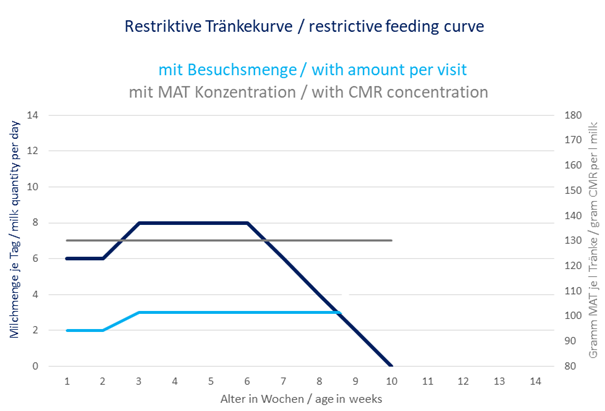
With a metabolic feeding curve, more milk is fed, right through to ad libitum provision. Higher quantities of milk are also required when aiming for daily weight gains of 1000 g and more.
However, the feed buckets always contain many litres of leftover milk, especially in the first few weeks. For this reason, calves should be fed gradually increasing amounts of milk in the bucket during the first week, even with a metabolic feeding curve. You can then use the MilkTaxi to set a daily quantity of about 8 litres for the first week, for example, and then increase this to 15-18 litres in the second and third weeks.
You can easily monitor this learning phase at the feeder through amounts that were not called up. However, such amounts do not need to trigger an alarm, as long as the calves drink 6-8 litres of milk per day.
The plateau phase
Calves are able to drink larger quantities of milk after 2-3 weeks.
In a restrictive feeding curve, you would feed e.g. 8 litres per animal per day and maintain this amount right through to weaning.
Around 22 MJ of metabolisable energy are required for daily gains of 800 to 1,000 g for a calf weighing 50 kg. This means at least 9 l of whole milk or 1,500 g of CMR. Consequently, quantities of over 10 l up to ad libitum intake are often set during metabolic feeding. This equates to a maximum of 15-18 litres when feeding by buckets with two feeds, as the buckets only have a volume of 9 litres. It is very easy to set high feeding quantities on the calf feeder, because the feeding quantity can be divided into small portions using the visit quantity function (see below).
You can set a daily amount of e.g. 12 litres if you do not explicitly wish to feed ad libitum at the feeder. A calf will then receive up to 1,800 g of CMR per day with an increased CMR concentration of e.g. 150 g/l feed.
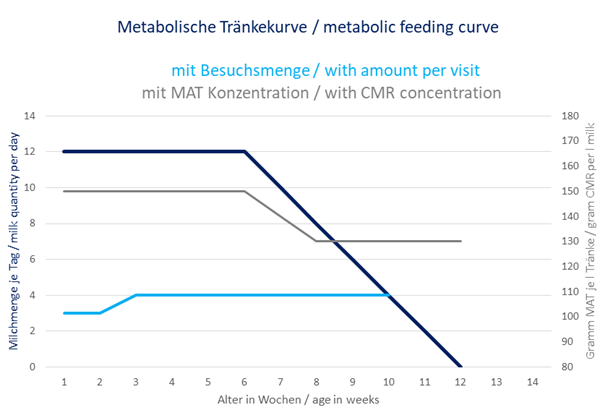
The weaning phase
The duration of the plateau phase should be based on the calves' intake of concentrated feed. Weaning can begin once the animals consume enough dry feed to compensate for the missing energy from the milk. You can find detailed information on this in our blog article "Powerfood for Calves".
As a rule of thumb, it can be said that gradual weaning can be started at a concentrate intake of 1 kg per day. It is difficult to determine this when keeping animals in groups. This is why weaning is usually undertaken according to age.
Since a calf's digestive system can only adapt slowly to solid feed, a reduction in the quantity of milk should be effected over a period of 4-6 weeks in order to avoid a drop in growth following weaning.
You could, for example, start at 6 weeks of age during the restrictive feeding curve and wean over a period of 4 weeks. When bucket feeding with the MilkTaxi, you could feed 2 litres each week. Appropriate markings on the hutches can help here.
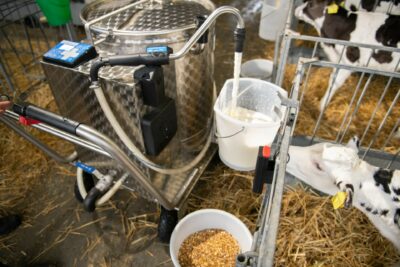
Milk can be reduced by a few 100 ml every day at the calf feeder or at the MilkTaxi with integrated box recognition and feeding curve (SmartID option). This results in the least amount of stress for calves during the transition.
It is also ideal to start weaning at the age of 6 weeks during metabolic feeding. Again, do not reduce by more than 2 litres per week to ensure gradual adjustment of the digestive system to solid food.
However, the higher initial quantity considerably prolongs the weaning phase. It is possible that calves may not be fully weaned until they are 12-14 weeks old instead of 10 weeks. This is explicitly recommended by some researchers, because even at 10-12 weeks of age a calf's digestive system is not yet fully developed and high concentrate intakes can cause acidosis in the digestive tract.
Other experts recommend that the feeding of high milk quantities should be preceded by what they term a "step-down". This is a big reduction in the amount of milk, for example from 12 l to 8 l. This tells the calf that it's time to eat concentrate. The calf still derives enough energy from the milk for good growth, even with this large decrease. However, the calf develops a sense of hunger as a result of the lack of milk and then consumes more concentrate.
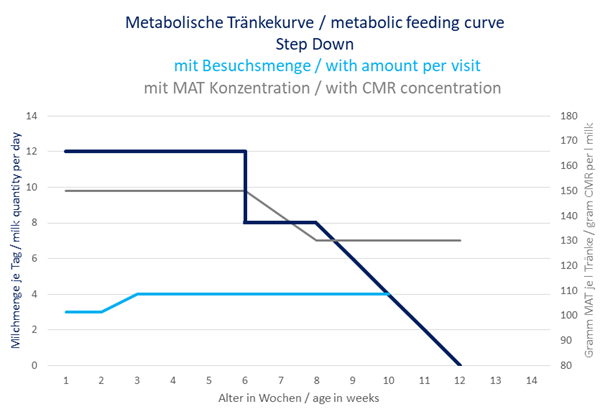
5. Weaning by body weight
Calf growth has proven to be a good alternative for determining the ideal time for weaning, since recording individual concentrate intake in group housing is difficult to accomplish in practice. This is because this additional growth is very likely to be accompanied by a higher intake of concentrate if all calves receive the same amount of milk according to the feeding curve, but some calves develop better than others. Higher daily weight gains are therefore a good indicator for earlier weaning.
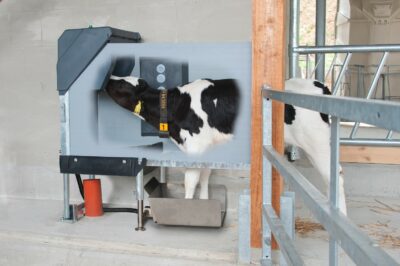
In practical terms, this can only be implemented using the calf feeder, since it is equipped with animal weigh scales. The scales record the weights of the calves at every visit and can thus reliably calculate their weight on a daily basis. An additional weaning program is then activated in parallel to the weaning curve by age (see above), which only takes effect if a calf develops better than other calves based on the specifications.
But when should you start weaning based on weight gain?
This is a question that each farmer must decide for themself. Feed intensity, breed, space available and feed costs must all be taken into account. However, using a rule of thumb rule from the USA as a guide might help: A calf should be weaned once its birth weight has doubled. Nevertheless, take note: this principle applies there to calves that have been "restrictively" fed.
Our recommendation would be: "Begin the slow weaning phase when birth weight has doubled. The weaning rate is also linked to weight development, i.e. the more the calf gains weight, the faster it is weaned.
In practical terms, this means that a calf with a birth weight of 38 kg will be slowly weaned off milk at a weight of about 76 kg. A calf would be completely weaned off milk at a body weight of approx. 110 kg given a weaning rate of e.g. 0.4 l per kg weight gain and a milk volume in the plateau of 12 l.
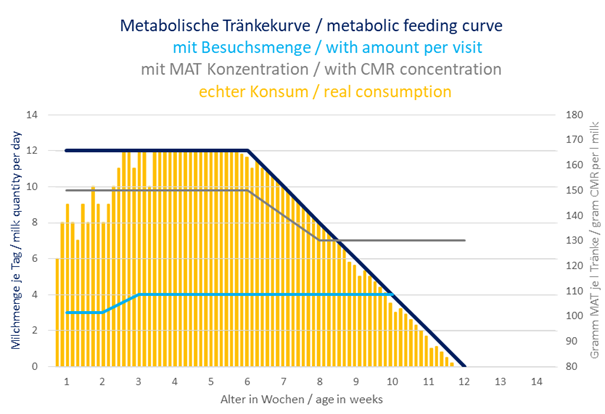
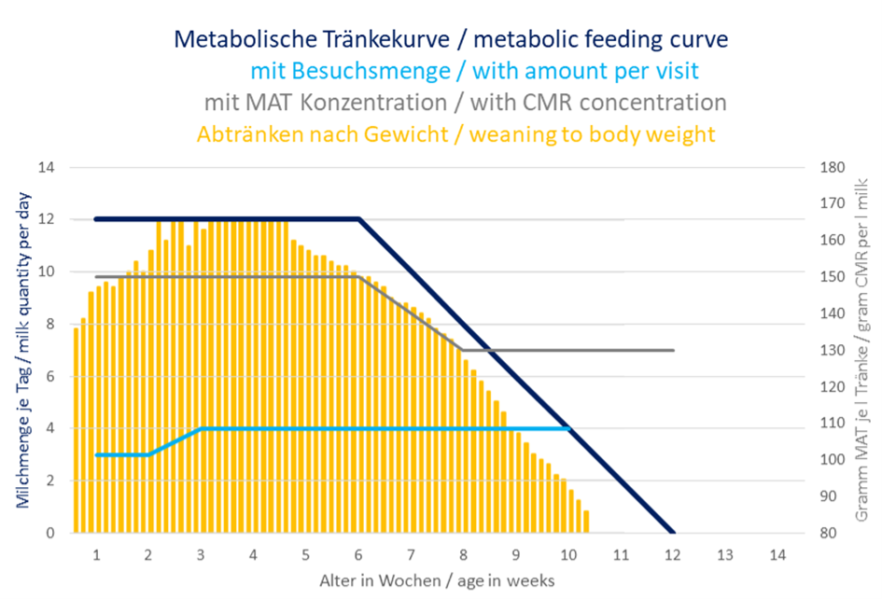
6. Feeding amount per visit and visit frequency
Do not feed too little or too much milk in one meal.
Feed at least 2 litres of milk per meal. Calves will not be full and will not have their suckling needs satisfied if the quantities per visit are low. This can lead to unease and reciprocal suckling.
Also make sure that all quantities are about the same on visit:
- Good distribution: daily amount: 8 l, visit amount 2 l; i.e. 4 visits with 2 l on each visit.
- Poor distribution: daily quantity 8 l, visit quantity 2.5 l; i.e. three visits with 2.5 l and one visit with 0.5 l.
Limit milk feed to a maximum of 3 litres for young calves (up to the age of 4 weeks) and to a maximum of 4 litres for older calves. You should also focus on slow increases here, just as you do with feed composition or CMR concentration. You can easily set this transition on the CalfExpert calf feeder, e.g. in a visit quantity curve.
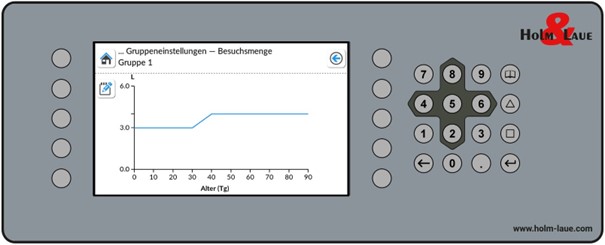
There is a risk that younger calves in particular will not yet visit the station very often during the first few days at the feeder. It is then advantageous for the calves to be able to call up a relatively large amount of milk on their first visit. 2-3 litres in one meal would already cover 50 % of the calf's sustenance requirements. A second visit rounds off the daily energy requirements and the nutrients from the third visit then ensure the calf's dynamic growth.
This contradicts earlier recommendations concerning calf feeders, which recommend programming many small portions. However, practice has shown that calves often do not have more than 4 regular visits where feed is called up at the feeding station. In other words, the number of visits must be set in such a way that the calf can call up the full amount even with only 4 visits. Calves only need more visits to retrieve everything when fed ad libitum with milk quantities of up to 20 l per day.
Visit quantities of 5 l or more are not recommended when feeding regular milk (whole milk or CMR). The calves are then so full that they often do not feed for many hours. The pH value in the abomasum can then drop sharply, leading to damage or even ulcers in the stomach wall.
With ad-libitum feeding with a bucket, much larger quantities of milk are offered in the bucket, as is well known. However, the permanent availability and raising the acidity of the milk to pH 5.5 ensures that feeding is slowed. In this case, calves consume their high quantity of milk spread over many visits during the day, similar to a feeder.
Ad libitum feeding
The metabolic feeding curve described in this article is not an ad libitum curve. Most calves would consume more than 12 litres. However, it is possible to program higher quantities on the calf feeder. However, missing call-off quantities must then be regularly expected and these will be added to the feeder's alarm list. The Holm & Laue CalfExpert accounts for this fact and only issues an alert when a calf's milk consumption falls below a critical threshold.
You can find out more about feeding recommendations for ad libitum feeders in the next blog article.

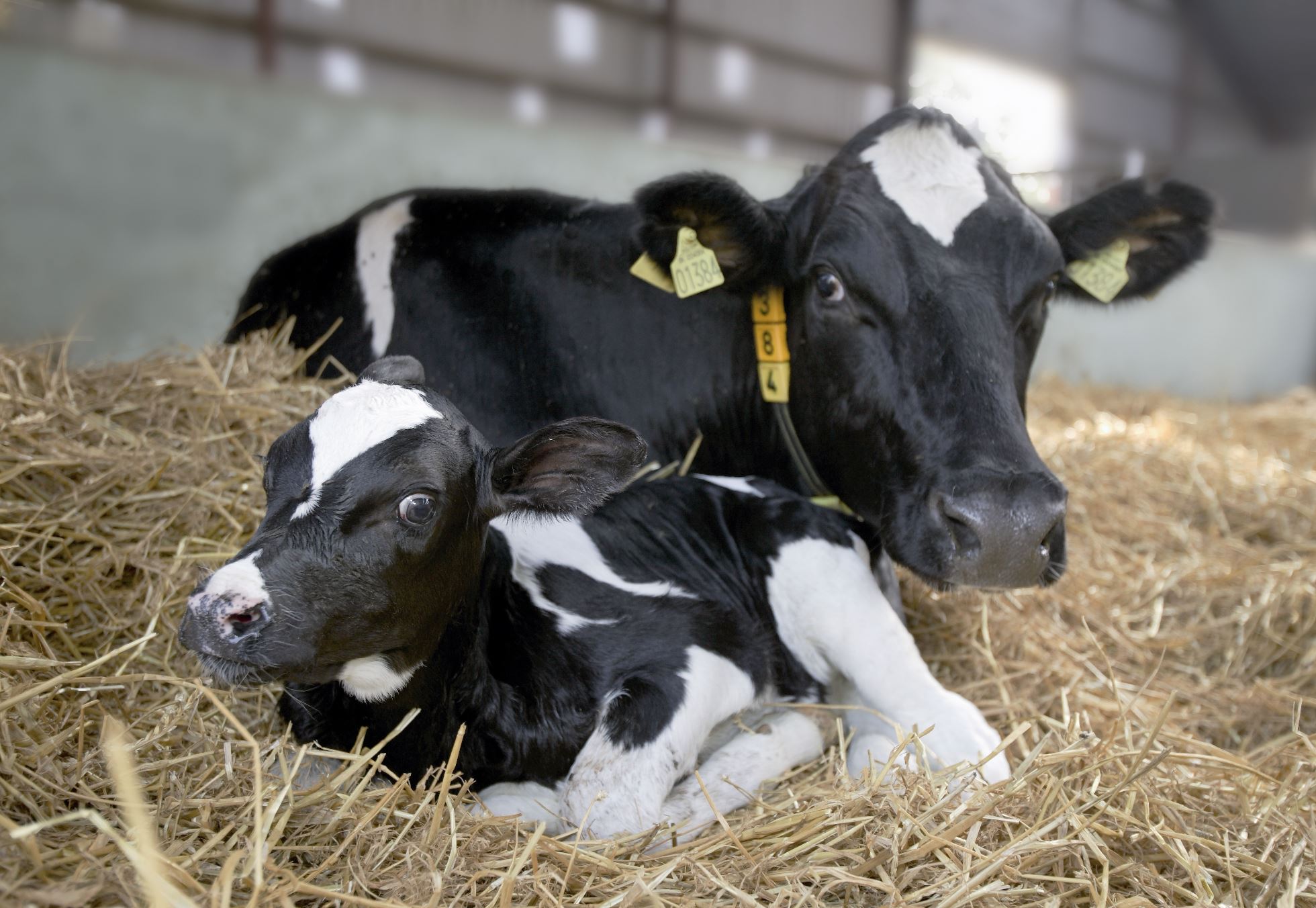
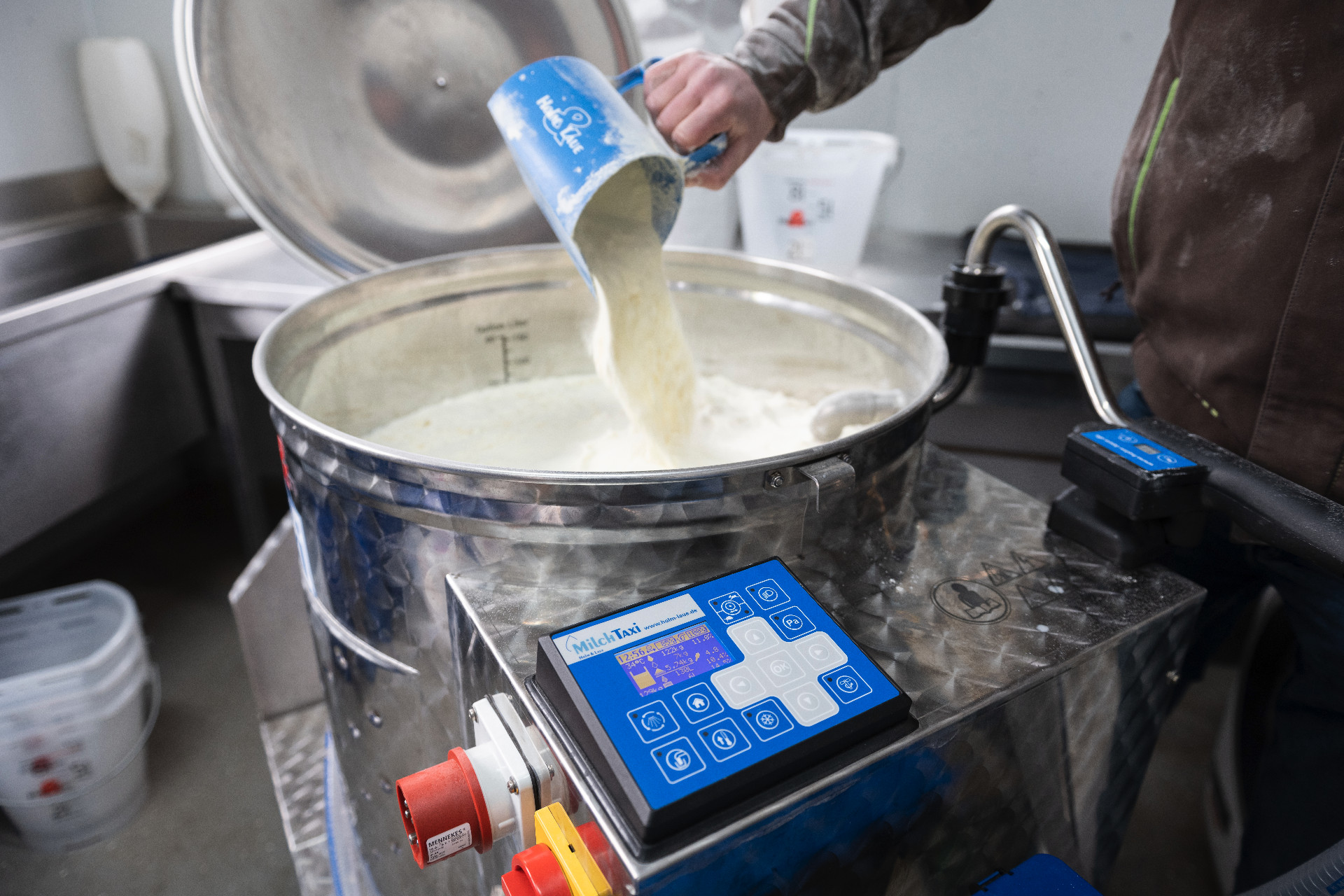
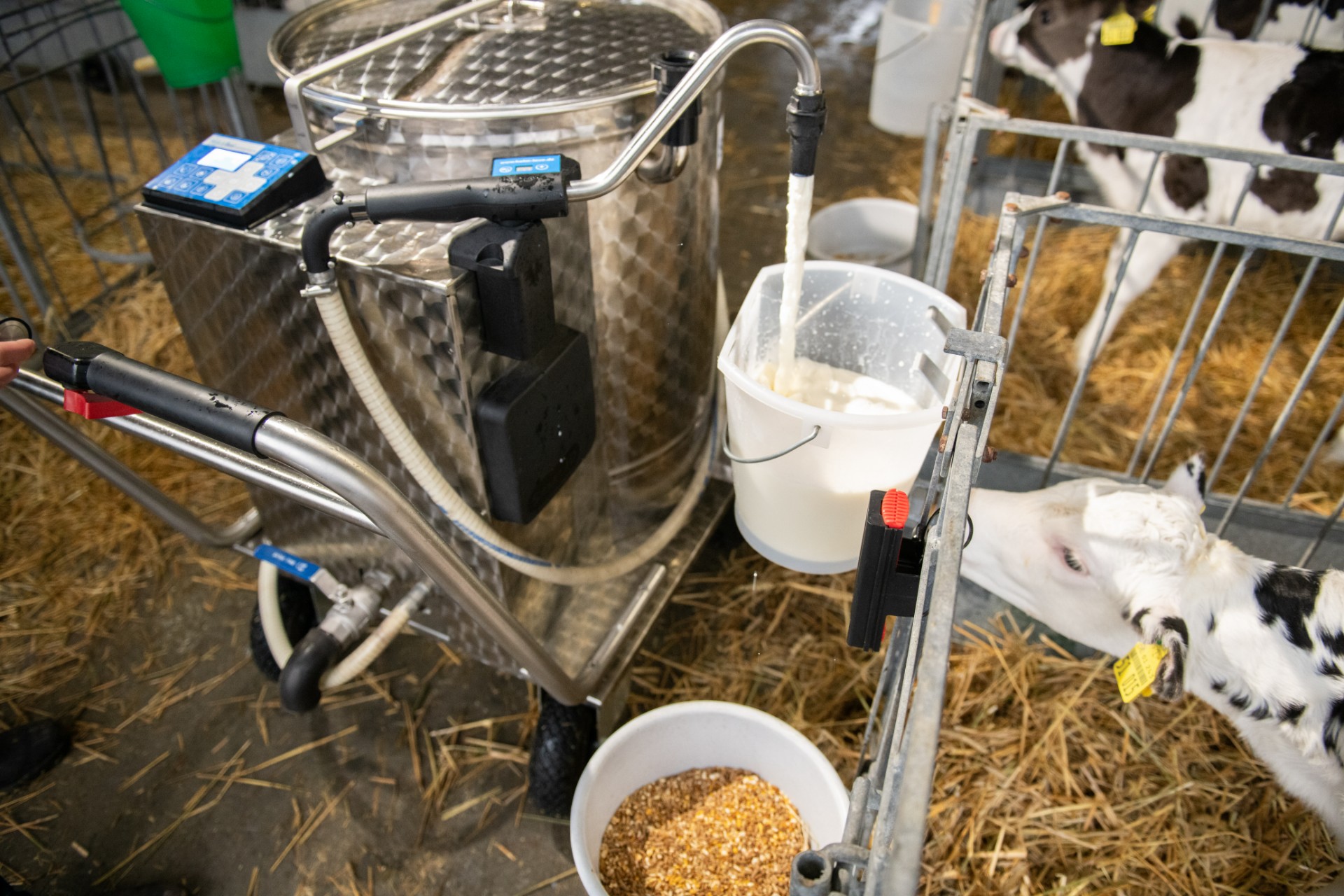
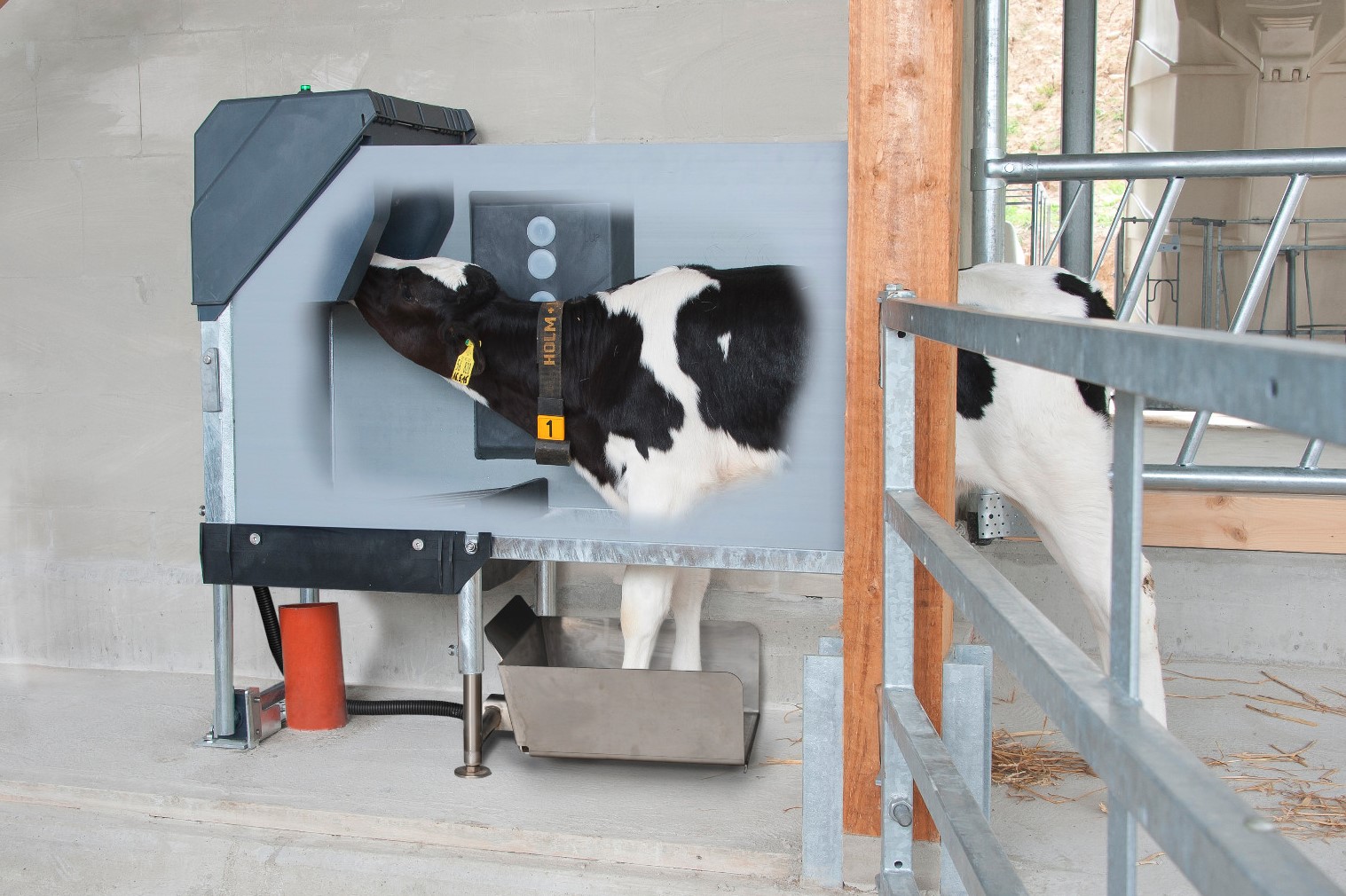 Calf feeding in a HygieneStation with front-foot scales
Calf feeding in a HygieneStation with front-foot scales
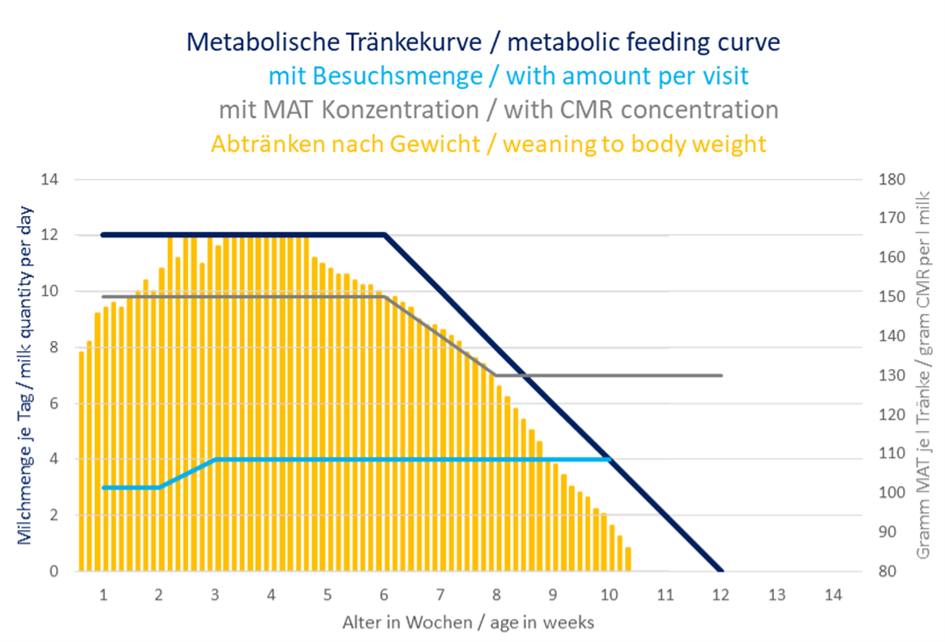 Weaning behaviour of a calf over a metabolic drinking curve when weaning by body weight.
Weaning behaviour of a calf over a metabolic drinking curve when weaning by body weight.